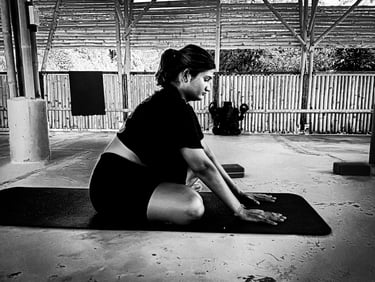Managing Motion Sickness
Motion sickness is complex, and individual responses can vary widely. For some, dynamic yoga sequences—with their flowing transitions and shifting focus—can heighten sensations of dizziness or nausea, particularly when body awareness is still developing.
While yoga doesn’t promise to “fix” motion sensitivity, certain postures may help individuals manage symptoms by providing stability, reducing sensory input, and building internal awareness. Static poses like Adho Mukha Sukhasana can offer a gentle, grounding alternative for those navigating these challenges.
Grounding and Stability
The seated position itself is inherently grounding. When you fold forward from this stable base, you increase the sense of being rooted and connected to the earth. This physical stability can be incredibly reassuring for someone experiencing or anticipating motion sickness, as it directly counteracts feelings of instability and disorientation.
Reduced Visual Overstimulation
The forward fold naturally limits your visual field and encourages an inward gaze. For people with motion sickness, conflicting visual input can worsen symptoms by creating discord between what the eyes see and what the inner ear senses. By reducing this visual stimulation and turning attention inward, the pose helps minimize sensory overload.
Gentle Muscular Engagement
This pose involves subtle but meaningful physical work. Lengthening the spine on each inhale engages the back muscles gently, followed by release and relaxation as you deepen the fold on the exhale. This controlled cycle of engagement and release introduces the concept of muscular work safely, without triggering dizziness or nausea.
Enhanced Body Awareness
Static poses like this one develop two crucial types of awareness:
Proprioception (Spatial Awareness): Holding the pose helps you become acutely aware of where your body parts are in relation to each other and to the ground. You learn to feel subtle shifts, weight distribution, and alignment—creating an internal map that's essential for safer movement.
Interoception (Internal Sensations): The static hold encourages deep listening to internal sensations: the quality of the stretch, subtle muscle engagement, breath rhythm, and even your heartbeat. This internal awareness improves your ability to respond to your body's signals, preventing overexertion and reducing the likelihood of triggering motion sensitivity.
Building a Foundation for Movement
Static poses teach us the language of our bodies in stillness. This understanding creates the foundation for approaching dynamic movement with greater fluency, grace, and confidence. For those with motion sickness, this methodical approach to body awareness can make the eventual transition to flowing sequences not just possible, but genuinely therapeutic and less likely to trigger symptoms.


More Insights
